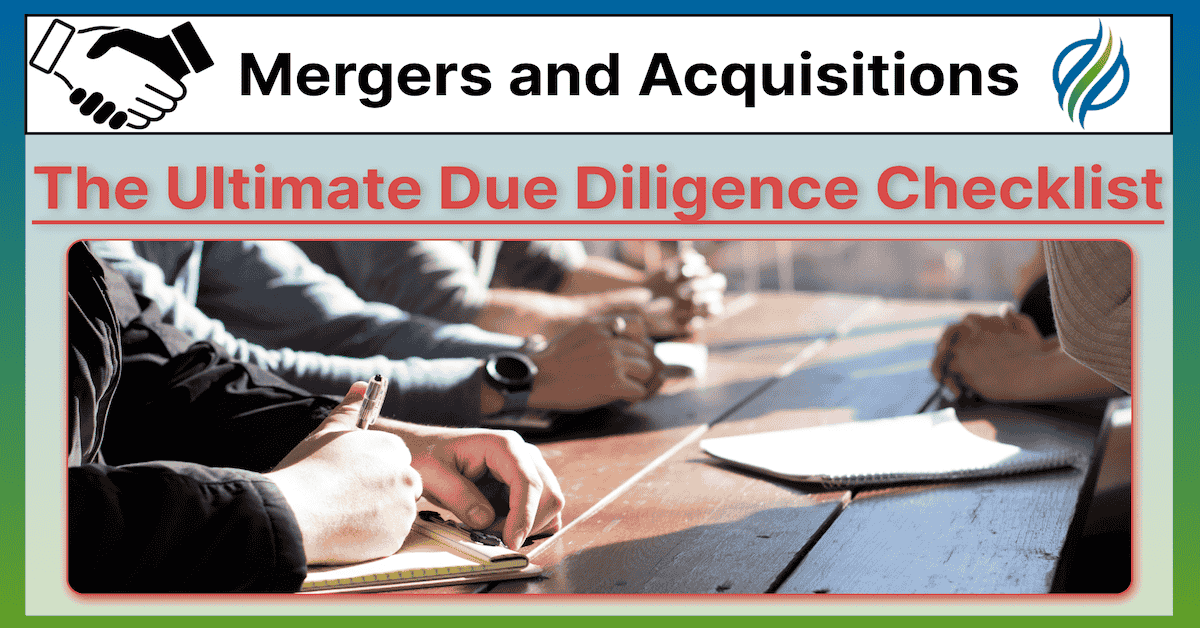Due diligence is a critical process in mergers and acquisitions (M&A) that ensures all aspects of the target company are thoroughly evaluated before finalizing a transaction.
This Ultimate Due Diligence Checklist is designed to guide you through a comprehensive review of the target company’s financials, operations, legal matters, and strategic fit.
By systematically addressing each section of this checklist, you can mitigate risks, uncover hidden liabilities, and make informed decisions that contribute to the success of the transaction.
 Key Takeaways
Key Takeaways
- Mitigate Risks: Thorough due diligence identifies and mitigates financial, operational, and legal risks in M&A transactions.
- Evaluate Financial Health: Assess financial statements, revenue streams, and debt structure to understand the target company's financial stability.
- Check Legal Compliance: Review legal matters, including contracts and intellectual property, to avoid future liabilities.
- Strategic Fit: Ensure the target company aligns with your strategic goals and can be integrated smoothly.
- Consult Experts: Engage financial, legal, and industry experts to interpret complex information and provide professional insights.
How to Use this Checklist
1. Systematic Approach: Follow the checklist in the order provided. Each section builds on the previous one, ensuring a comprehensive review.
2. Document Review: Gather and review relevant documents for each section. This may include financial statements, contracts, patents, employee agreements, and more.
3. Self-Assessment Questions: Answer the self-assessment questions provided in each section. These questions are designed to highlight key areas of concern and ensure a thorough analysis.
4. Resource Utilization: Use the list of resources provided at the end of each section’s page to find the additional information to help you answer the self-assessment questions.
5. Consult Experts: Engage with legal, financial, and industry experts as needed to interpret complex information and provide professional insights.
6. Regular Updates: Update the checklist regularly to reflect any new information or changes in your target company’s circumstances.
Table of Contents
- 1. Financial Due Diligence
- 2. Tax Compliance & Liabilities
- 3. Asset Appraisal & Valuation
- 4. Technology & Intellectual Property
- 5. Customers & Sales
- 6. Strategic Fit & Compatibility
- 7. Material Contracts
- 8. Employees & Management
- 9. Litigation & Legal Issues
- 10. Operational Efficiency & Risks
- 11. Antitrust & Regulation
- 12. Insurance
- 13. General Corporate Matters
- 14. Environmental
- 15. Related Party Transactions
- 16. Governmental Regulations, Filings, & Legal Compliance
- 17. Property
- 18. Production-Related Matters
- 19. Marketing Arrangements
- 20. Competitive Landscape
- 21. Media & Public Perception
1. Financial Due Diligence

Financial due diligence involves a detailed review of the target company’s financial statements and related financial information to ensure the accuracy and completeness of the financial data presented.
This step is critical because it helps the buyer understand the target’s financial health, historical performance, and future projections, ensuring that the buyer makes an informed decision about the acquisition.
➤ MORE: Confirm the accuracy and completeness of any business's financial data
Review Audited Financial Statements (last 3-5 years):
Obtain the company’s annual, quarterly, and (if available) monthly financial statements for the last three to five years.
Verify the auditor’s credibility and look for any notes or qualifications in the audit report.
Cross-check financial data with other internal records of the company.
Audited financial statements provide a verified and accurate picture of the company’s financial health, helping to ensure that the information presented is reliable and comprehensive.
Analyze Revenue Streams, Profitability Trends, and Cost Structures:
Break down revenue by customer, product line, and geography.
Identify the top customers and the percentage of total revenue they represent.
Review contracts with key customers to understand terms and potential risks.
Understanding revenue streams helps identify the stability and sustainability of revenue, highlighting any over-reliance on specific customers or products.
Examine Forecasts, Budgets, and Financial Projections:
Obtain and review the company’s budgets and financial projections.
Compare historical performance to projections to assess accuracy.
Analyze assumptions underlying the projections for reasonableness.
Reviewing forecasts and budgets ensures that the buyer has realistic expectations of the company’s future performance.
Assess Debt and Equity Structure:
List all debt instruments, including terms, interest rates, and maturity dates.
Analyze covenants and restrictions associated with the debt.
Review equity structure, including shares outstanding, options, and warrants.
Understanding the debt and equity structure helps assess financial leverage and risk.
Verify Working Capital and Capital Expenditure Requirements:
Calculate current working capital by reviewing current assets and liabilities.
Assess historical trends in working capital requirements.
Review capital expenditure plans and budgets for future investments.
Verifying working capital and capital expenditure requirements ensures that the company has sufficient resources to maintain operations and support growth.
This helps assess the company’s liquidity and operational needs.
Conduct Quality of Earnings Report:
Hire an independent financial advisor to conduct the report.
Review non-recurring items, revenue recognition policies, and expense matching.
Analyze adjustments to EBITDA for accuracy.
A quality of earnings report helps validate the true earning power of the company.
Examine Loan and Credit Agreements:
Obtain copies of all loan and credit agreements.
Review terms related to interest rates, covenants, and repayment schedules.
Examining loan and credit agreements helps identify the company’s financial obligations and potential risks.
Assess Accounts Receivable and Revenue Recognition:
Review the aging of accounts receivable and any revenue recognition issues.
This helps understand the company’s cash flow and potential risks related to receivables.
Identify Cost Savings:
Assess the potential cost savings that can be obtained after the acquisition.
Identify marginal costs, such as costs of obtaining third-party consents.
Identifying cost savings helps justify the acquisition price and enhance the overall value of the deal.
2. Tax Compliance & Liabilities

Tax compliance and liabilities review focuses on evaluating the target company’s tax history, current tax obligations, and potential tax issues.
This step is vital to identify any tax risks and ensure that the acquisition does not result in unexpected tax liabilities.
➤ MORE: Prevent unexpected liabilities in a business acquision
Assess Current and Deferred Tax Liabilities:
Obtain the company’s latest tax returns and financial statements.
Review the tax notes in the financial statements for deferred tax assets and liabilities.
Analyze the company’s tax strategies and the potential impact of changes in tax laws.
Assessing current and deferred tax liabilities identifies potential tax burdens and their impact on the company’s financial position.
Analyze Government Audits:
Review any government audits the company has undergone.
This helps assess the company’s compliance with tax laws and identify any potential liabilities.
Review Tax Compliance History and Potential Red Flags:
Obtain copies of tax filings for the last 5 years.
Check for any audits or disputes with tax authorities.
Verify the company’s compliance with federal, state, and local tax laws.
Reviewing the tax compliance history identifies potential compliance risks and any history of tax disputes.
Examine Correspondence with Tax Authorities:
Obtain copies of any correspondence or notices from tax authorities regarding filed tax returns or any tax-related issues.
This helps identify ongoing or potential tax issues.
Examine Tax Implications of the Deal:
Consult with tax advisors to analyze the tax implications.
Review potential tax benefits, such as net operating losses (NOLs).
Evaluate tax structuring options to minimize liabilities.
Analyzing the tax implications of the deal ensures that the buyer understands the tax consequences and can plan accordingly.
Verify Tax Attributes (e.g., NOLs):
List all tax attributes and their amounts.
Confirm the availability and usability of these attributes post-acquisition.
Review any limitations on the use of these attributes due to changes in ownership.
Verifying tax attributes identifies potential tax benefits that can reduce future tax liabilities.
Assess Net Operating Losses and Credit Carryforwards:
Identify any net operating losses (NOLs) or credit carryforwards and their potential benefits.
This helps maximize tax benefits post-acquisition.
Review IRS Forms and Tax Sharing Agreements:
Obtain copies of all relevant IRS forms and tax-sharing agreements.
Review terms and conditions of these agreements.
Analyze any shared tax liabilities and their impact on the transaction.
Reviewing IRS forms and tax-sharing agreements ensures that all tax obligations are understood and managed.
Review Tax Sharing and Transfer Pricing Agreements:
Analyze any tax sharing and transfer pricing agreements.
This helps assess potential tax liabilities and compliance with transfer pricing regulations.
3. Asset Appraisal & Valuation

Asset appraisal and valuation involve determining the fair market value of the target company’s assets, including both tangible and intangible assets.
This process is crucial to ensure that the buyer is paying a fair price for the company and to identify any potential issues related to asset ownership and condition.
➤ MORE: Make sure you're paying the right price in any business acquisition
Verify Existence and Condition of Tangible Assets (properties, equipment, inventory, etc.):
Conduct site visits to inspect physical assets.
Review inventory reports and asset registers.
Verify ownership documents and assess the condition of major assets.
Verifying the existence and condition of tangible assets ensures that all assets listed on the balance sheet exist and are in good condition.
Appraise Intangible Assets (patents, trademarks, goodwill):
List all intangible assets and their carrying values.
Use valuation methods such as discounted cash flow (DCF) or market multiples.
Verify ownership and assess the marketability of intangible assets.
Appraising intangible assets ensures that valuations are reflective of their true worth and marketability.
Identify Off-Balance-Sheet Assets and Liabilities:
Review notes to the financial statements for off-balance-sheet items.
Identify any contingent liabilities, such as pending lawsuits or guarantees.
Assess the impact of these items on the company’s financial health.
Identifying off-balance-sheet assets and liabilities provides a complete picture of the company’s financial obligations and potential risks.
Evaluate Asset Liens and Encumbrances:
Obtain a title search for major assets.
Review lien filings and other encumbrance documents.
Verify the process for clearing any liens at closing.
Evaluating asset liens and encumbrances ensures that assets are free of legal claims that could affect their value or transferability.
4. Technology & Intellectual Property

You should take a keen interest in the extent and quality of the target company’s technology and intellectual property.
This due diligence will often focus on identifying valuable patents, trademarks, copyrights, and trade secrets, as well as assessing any potential risks related to intellectual property infringement or disputes.
➤ MORE: Discover the potential risks related to IP infringement or disputes
Review Patents, Patents Pending, Trademarks, Copyrights, & Trade Secrets:
Obtain a list of all domestic and foreign patents, including those pending.
Verify the status and ownership of each patent.
Reviewing patents helps identify the proprietary technologies that the company owns and their potential competitive advantage.
Assess Intellectual Property Protection Measures and Licensing Agreements:
Review confidentiality and invention assignment agreements with current and former employees and consultants.
Assess any material exceptions from such assignments.
Proper IP protection measures ensure that the company’s intellectual property is adequately safeguarded.
You can use the target company’s IP portfolio to find out more information about any current or pending patents they may have.
Evaluate Trademarks and Service Marks:
Obtain a list of registered and common law trademarks and service marks.
Verify the status and ownership of each mark.
Evaluating trademarks helps ensure that the company’s brand and product identifiers are legally protected.
Review Copyrighted Products and Materials:
Identify all copyrighted products and materials used, controlled, or owned by the company.
Verify the status and ownership of each copyright.
Reviewing copyrights helps ensure that the company’s creative works are legally protected.
Assess Trade Secrets and Confidential Information:
Determine if the company’s business depends on the maintenance of any trade secrets.
Review the steps taken by the company to preserve the secrecy of its trade secrets.
Assessing trade secrets helps ensure that critical proprietary information is adequately protected.
Evaluate IP Infringement Risks:
Determine if the company is infringing on (or has infringed on) the intellectual property rights of any third party.
Assess any IP litigation or disputes.
Evaluating IP infringement risks helps identify potential legal and financial liabilities.
5. Customers & Sales

The buyer will want to fully understand the target company’s customer base, including the level of concentration of the largest customers as well as the sales pipeline.
This due diligence will focus on identifying key customers, assessing customer satisfaction, and evaluating any risks related to customer retention.
➤ MORE: Uncover any risks associated with customer dependency and retention
Identify Top Customers and Revenue Concentration:
List the top 20 customers and the revenues generated from each.
Assess any customer concentration risks.
Identifying top customers helps determine the stability of the company’s revenue and potential risks related to customer dependency.
Assess Customer Satisfaction and Retention Risks:
Review customer feedback and satisfaction surveys.
Conduct customer calls if appropriate.
Assess any risks related to customer retention, especially after the acquisition.
Evaluating customer satisfaction helps ensure that the company maintains strong customer relationships post-acquisition.
Review Sales Terms and Policies:
Examine the company’s sales terms, policies, and any unusual levels of returns, exchanges, or refunds.
Reviewing sales terms helps identify any potential issues related to sales practices and customer satisfaction.
Evaluate Sales Pipeline and Seasonality:
Analyze the company’s sales pipeline and any seasonality in revenue and working capital requirements.
Evaluating the sales pipeline helps assess the predictability and stability of future revenue.
Review Sales Compensation and Motivation:
Assess how salespeople are compensated and motivated.
Evaluate the impact of the acquisition on financial incentives offered to employees.
Reviewing sales compensation helps ensure that the sales team remains motivated and effective post-acquisition.
6. Strategic Fit & Compatibility

You should be concerned not only with the likely future performance of the target company as a stand-alone business, but also with the extent to which the company will fit strategically within your larger organization.
Assessing the strategic fit and planning for post-merger integration is crucial for realizing the full value of the acquisition.
This involves evaluating how well the target company aligns with the your strategic goals and planning the integration process.
Understanding these aspects helps in identifying potential challenges and developing strategies to achieve a smooth transition.
➤ MORE: Ensure a perfect fit between your organization and the business you plan to buy
Assess Strategic Alignment:
Determine if there is a strategic fit between the company and the buyer.
Analyze how the target company’s business, products, and markets align with the buyer’s strategic goals.
Assess whether the fit is based on a historical business relationship or unproven future expectations.
Evaluating strategic alignment helps ensure that the acquisition supports the buyer’s long-term goals.
Evaluate Corporate Culture and Alignment with Buyer
Corporate culture encompasses the values, behaviors, and practices that define how a company operates and interacts with its employees, customers, and stakeholders.
Evaluate the cultural compatibility between the target company and the buyer.
Assessing the cultural alignment between the buyer and the target company helps in identifying potential areas of conflict and ensuring a harmonious integration that minimizes conflicts.
1. Conduct Cultural Assessments:
Use cultural assessment tools and surveys to evaluate the target company’s corporate culture.
Compare the results with the buyer’s corporate culture to identify similarities and differences.
2. Analyze Mission, Vision, and Values:
Review the mission, vision, and values statements of both companies.
Assess how well these align and where there may be discrepancies.
3. Observe Workplace Practices:
Conduct site visits to observe the target company’s workplace practices and environment.
Identify any practices that differ significantly from the buyer’s practices.
4. Engage with Key Stakeholders:
Hold discussions with key stakeholders, including management and employees, to gain insights into the company’s culture.
Understand their perspectives on the potential merger or acquisition.
Review Training and Development Programs:
Obtain information on the company’s training and development programs.
This helps assess the company’s commitment to employee growth and development.
Evaluate Product, Service, or Technology Fit:
Determine if the target company provides products, services, or technology that you, as the buyer, don’t have.
Assess the potential benefits of these additions to the your organization’s portfolio.
Evaluating product and technology fit helps identify potential areas for growth and diversification.
Evaluate HR Policies, Practices, and Employee Morale
Evaluating the human resources and cultural fit of the target company is essential for a successful acquisition.
This involves reviewing HR policies, employee agreements, and cultural compatibility.
HR policies and practices play a significant role in shaping the employee experience and maintaining high levels of morale.
Evaluating these aspects helps identify strengths and areas for improvement, ensuring a supportive work environment.
1. Review HR Policies and Procedures:
Obtain and review the target company’s HR policies and procedures, including recruitment, onboarding, performance management, and benefits.
Assess how comprehensive and up-to-date these policies are.
2. Analyze Employee Morale and Satisfaction:
Conduct employee satisfaction surveys and review the results.
Identify areas of high and low employee morale and the underlying causes.
3. Assess Compensation and Benefits:
Evaluate the compensation and benefits packages offered by the target company.
Compare these with industry standards and the buyer’s offerings.
4. Review Turnover Rates and Retention Strategies:
Analyze employee turnover rates and the effectiveness of retention strategies.
Identify any patterns or trends in employee turnover.
5. Engage with HR Professionals:
Hold discussions with the target company’s HR professionals to understand their perspectives on HR practices and employee morale.
Gather insights on any ongoing HR initiatives or challenges.
Plan for Cultural Integration and Retention of Key Employees
Planning for cultural integration and the retention of key employees is essential for ensuring a smooth transition and maintaining business continuity.
This involves developing strategies to align cultures, retain critical talent, and address potential challenges.
1. Develop a Cultural Integration Plan:
Create a detailed plan for integrating the corporate cultures of the buyer and the target company.
Include strategies for addressing cultural differences and fostering a unified culture.
2. Identify and Retain Key Employees:
Identify key employees who are critical to the success of the merged entity.
Develop retention plans and incentives to ensure these employees remain with the company.
3. Implement Communication Strategies:
Develop clear communication strategies to keep employees informed and engaged throughout the integration process.
Address any concerns and provide regular updates on the progress of the integration.
4. Provide Training and Support:
Offer training and support to help employees adapt to new systems, processes, and cultural changes.
Provide resources for employees to voice their concerns and seek assistance.
5. Monitor Integration Progress:
Establish metrics and regularly monitor the progress of cultural integration and employee retention efforts.
Adjust strategies as needed based on feedback and performance data.
7. Material Contracts

One of the most time-consuming but critical components of a due diligence inquiry is the review of all material contracts and commitments of the target company.
The categories of contracts that are important to review and understand include customer and supplier contracts, employment agreements, and any other significant agreements.
Review Customer and Supplier Contracts:
Obtain copies of all major customer and supplier contracts.
Verify the terms, conditions, and any change-of-control provisions.
Reviewing these contracts helps identify the stability of business relationships and any potential risks.
Evaluate Employment Agreements:
Obtain copies of employment agreements for key employees.
Review terms related to compensation, benefits, and termination.
Evaluating employment agreements helps identify any potential liabilities and ensures that key employees are retained post-acquisition.
Review Partnership and Joint Venture Agreements:
Obtain copies of any partnership or joint venture agreements.
Verify terms and conditions, including profit-sharing arrangements and management responsibilities.
Reviewing these agreements helps understand the company’s collaborative relationships and potential risks.
8. Employees & Management

The buyer will want to review a number of matters to understand the quality of the target company’s management and employee base.
This includes assessing the management team, labor relations, and employee benefits.
Review Management Organization Chart and Biographies:
Obtain the management organization chart and biographies of key executives.
Review their qualifications, experience, and performance.
This helps assess the quality of the leadership team and identify any gaps.
Assess Labor Relations and Disputes:
Review any information concerning labor disputes, including previous, pending, or threatened labor stoppages.
This helps identify potential risks related to labor relations and union activities.
Assess Employee Satisfaction and Turnover:
Evaluate employee satisfaction and turnover rates.
This helps identify potential HR issues and areas for improvement.
Examine Employee Benefits and Compensation Plans:
Obtain summaries of employee benefits and compensation plans, including pension, profit-sharing, and retirement plans.
Reviewing these plans helps identify potential liabilities and ensures that the company’s compensation structure is competitive.
Evaluate Key Employee Retention Plans:
Review any retention or incentive plans for key employees.
This helps ensure that critical talent remains with the company post-acquisition.
Analyze Compliance with Employment Laws:
Verify the company’s compliance with employment laws and regulations.
This helps identify potential legal risks and ensures that the company is not exposed to liabilities related to non-compliance.
9. Litigation & Legal Issues

Assessing litigation and legal issues is critical in due diligence to understand the legal landscape of the target company.
This section involves a thorough review of all pending, threatened, or settled litigation, regulatory compliance, potential investigations, intellectual property (IP) matters, patents, incorporation documents, and adherence to industry-specific regulations.
Identifying and understanding these issues helps in evaluating potential risks and liabilities that could affect the transaction.
➤ MORE: Ensure the company you're looking to purchase doesn't have any red flags...
Review Pending, Threatened, or Settled Litigation
Pending, threatened, or settled litigation can have significant financial and reputational impacts on a company.
Understanding the nature and scope of these legal issues is essential to assess potential liabilities and risks.
1. Obtain Legal Documentation:
Acquire all relevant documentation related to pending, threatened, or settled litigation, including court filings, settlement agreements, and legal correspondence.
Consult with the target company’s legal counsel for comprehensive details.
2. Analyze Legal Cases:
Review the details of each case to understand the claims, defenses, and potential outcomes.
Assess the financial implications, including legal fees, potential damages, and settlement amounts.
3. Evaluate Impact on Business Operations:
Determine how these legal issues could impact the company’s operations, reputation, and financial stability.
Identify any patterns or recurring legal problems that could indicate systemic issues within the company.
Assess Regulatory Compliance and Potential Investigations
Regulatory compliance is critical to avoid legal penalties and operational disruptions.
Assessing the company’s adherence to relevant regulations and any ongoing or potential investigations is crucial in identifying regulatory risks.
1. Review Compliance Records:
Obtain records of regulatory compliance, including audits, inspection reports, and correspondence with regulatory bodies.
Consult with regulatory compliance officers or legal counsel to understand compliance history.
2. Identify Regulatory Investigations:
Determine if there are any ongoing or potential regulatory investigations involving the company.
Assess the nature of these investigations and their potential impact on the company.
3. Evaluate Regulatory Environment:
Understand the regulatory environment specific to the industry and how it applies to the target company.
Identify any regulatory changes that could affect the company’s operations in the future.
Examine IP, Patents, and Incorporation Documents
Intellectual property and incorporation documents are fundamental to a company’s legal structure and competitive advantage.
Ensuring the validity and protection of IP assets and reviewing incorporation documents for compliance is crucial.
1. Review IP and Patent Documentation:
Obtain a list of all IP assets, including patents, trademarks, copyrights, and trade secrets.
Review patent filings, IP registration certificates, and any related legal documents.
2. Assess IP Protection Measures:
Evaluate the company’s measures to protect its IP, including confidentiality agreements and IP policies.
Identify any ongoing or potential IP litigation or disputes.
3. Examine Incorporation Documents:
Review incorporation documents, including articles of incorporation, bylaws, and shareholder agreements.
Ensure these documents comply with relevant laws and regulations.
Verify Compliance with Industry-Specific Regulations
Compliance with industry-specific regulations is essential to avoid legal penalties and ensure smooth operations.
Verifying adherence to these regulations helps identify potential legal risks and ensure regulatory compliance.
1. Identify Industry-Specific Regulations:
Determine the regulations specific to the industry in which the target company operates.
Consult with industry experts or legal counsel to understand these regulations.
2. Review Compliance Records:
Obtain records of compliance with industry-specific regulations, including audits, certifications, and inspection reports.
Assess the company’s procedures for maintaining compliance.
3. Evaluate Impact of Non-Compliance:
Identify the potential impacts of non-compliance, including legal penalties, operational disruptions, and reputational damage.
Determine any corrective actions the company has taken to address non-compliance issues.
10. Operational Efficiency & Risks

Understanding the operational efficiency and risks of a target company is crucial in the due diligence process.
This involves analyzing the company’s workflows, IT systems, cybersecurity measures, and internal control systems to identify areas of improvement and potential risks.
➤ MORE: Analyze your target company's workflows and make sure their systems run like they say they do...
Analyze Operational Workflows and Efficiency
Operational workflows are the backbone of a company’s daily operations.
Analyzing these workflows helps identify inefficiencies, bottlenecks, and areas for improvement, ensuring that the company operates smoothly and effectively.
1. Map Out Operational Workflows:
Create detailed flowcharts or diagrams of the company’s key operational processes.
Identify all steps involved, from raw materials to finished products or services.
2. Identify Bottlenecks and Inefficiencies:
Analyze each step to identify bottlenecks, delays, or inefficiencies.
Assess how these issues impact overall productivity and costs.
3. Evaluate Process Improvement Initiatives:
Review any initiatives the company has undertaken to improve operational efficiency.
Assess the effectiveness of these initiatives and their impact on operations.
4. Benchmark Against Industry Standards:
Compare the company’s operational workflows and efficiency metrics against industry standards.
Identify areas where the company lags behind or excels compared to competitors.
Evaluate IT Systems and Cybersecurity Measures
Information technology (IT) systems and cybersecurity measures are critical components of a company’s infrastructure.
Evaluating these systems helps ensure they are reliable, secure, and capable of supporting the company’s operations.
1. Review IT Infrastructure:
Assess the company’s IT infrastructure, including hardware, software, and network systems.
Identify any outdated or unsupported systems that may need upgrading.
2. Analyze IT System Performance:
Evaluate the performance and reliability of the IT systems.
Identify any recurring issues or downtimes that impact operations.
3. Assess Cybersecurity Measures:
Review the company’s cybersecurity policies, protocols, and practices.
Assess the effectiveness of these measures in protecting against cyber threats.
4. Conduct Vulnerability Assessments:
Perform or review recent vulnerability assessments and penetration tests.
Identify any critical vulnerabilities and the steps taken to mitigate them.
5. Evaluate Data Management Practices:
Assess how the company manages, stores, and protects data.
Ensure compliance with data protection regulations and best practices.
Assess Internal Control Systems and Procedures
Internal control systems and procedures are essential for ensuring accurate financial reporting, compliance with laws and regulations, and efficient operations.
Assessing these systems helps identify weaknesses and areas for improvement.
1. Review Internal Control Policies:
Obtain and review the company’s internal control policies and procedures.
Ensure these policies are comprehensive and up-to-date.
2. Evaluate Control Effectiveness:
Assess the effectiveness of internal controls through audits and testing.
Identify any weaknesses or gaps in the control environment.
3. Examine Compliance with Internal Controls:
Review compliance reports and audit findings related to internal controls.
Ensure that any issues identified have been addressed and resolved.
4. Assess Risk Management Practices:
Evaluate the company’s risk management practices, including how risks are identified, assessed, and mitigated.
Ensure that risk management is integrated into the internal control framework.
5. Benchmark Against Best Practices:
Compare the company’s internal control systems and procedures against industry best practices.
Identify areas for improvement and implement necessary changes.
11. Antitrust & Regulation

Antitrust and regulatory scrutiny of acquisitions has been increasing in recent years.
You will want to assess the antitrust or regulatory implications of a potential deal.
➤ MORE: Make sure the business you're looking to purchase is following the rules of their industry
Analyze Scope of Antitrust Issues:
Evaluate whether the acquisition might raise antitrust concerns.
This helps ensure that the deal complies with antitrust laws and regulations.
Review Regulatory Approvals Required:
Determine if the target company operates in a regulated industry requiring acquisition approval from regulatory bodies.
This helps identify necessary steps for regulatory compliance.
Evaluate Past Antitrust or Regulatory Inquiries:
Review any past antitrust or regulatory inquiries involving the target company.
This helps assess the company’s regulatory compliance history and potential risks.
Prepare for Hart-Scott-Rodino Filing:
If thresholds are met, prepare for a Hart-Scott-Rodino (HSR) filing and effectively respond to any “second request” from the Department of Justice or Federal Trade Commission.
Consider National Security or Foreign Investment Issues:
Evaluate any national security or foreign investment issues that might impact the acquisition, such as Exon-Florio concerns.
12. Insurance

In any acquisition, the buyer will want to undertake a review of key insurance policies of the target company’s business, including general liability, D&O, and other coverage types.
Review General Liability Insurance:
Obtain copies of general liability insurance policies.
Verify coverage limits, deductibles, and any exclusions.
Reviewing general liability insurance helps assess the company’s protection against common business risks.
Evaluate Directors and Officers (D&O) Insurance:
Obtain copies of D&O insurance policies.
Verify coverage limits, deductibles, and any exclusions.
Evaluating D&O insurance helps protect the company’s leadership against personal liability.
Assess Intellectual Property Insurance:
Review any intellectual property (IP) insurance policies. Verify coverage limits, deductibles, and any exclusions.
Assessing IP insurance helps protect the company’s valuable IP assets.
Review Employee Liability and Worker’s Compensation Insurance:
Obtain copies of employee liability and worker’s compensation insurance policies.
Verify coverage limits, deductibles, and any exclusions.
Reviewing these policies helps assess the company’s protection against employee-related risks.
Evaluate Key Man Insurance:
Determine if the company has key man insurance policies in place for critical executives.
Reviewing key man insurance helps protect the company against the loss of key personnel.
Assess Umbrella Policies:
Obtain copies of any umbrella insurance policies.
Verify coverage limits, deductibles, and any exclusions.
Assessing umbrella policies helps ensure comprehensive coverage for various risks.
13. General Corporate Matters

Counsel for the buyer will invariably undertake a careful review of the organizational documents and general corporate records (including capitalization) of the target company.
Corporate due diligence involves verifying the company’s legal structure, shareholder agreements, and other corporate governance matters.
Review Charter Documents:
Obtain and review the company’s charter documents (certificate of incorporation, bylaws, etc.).
This helps ensure that the company is legally constituted and operates according to its founding documents.
Verify Good Standing Certificates:
Obtain certificates of good standing from relevant authorities.
This helps confirm that the company is in compliance with state requirements and authorized to do business.
Review List of Subsidiaries:
Obtain a list of all subsidiaries and their respective charter documents.
This helps understand the corporate structure and the relationship between the parent company and its subsidiaries.
Examine Stockholder and Voting Agreements:
Review agreements that detail the rights and obligations of stockholders.
This helps identify any restrictions or obligations related to ownership and voting.
Verify Stock Option Plans:
Obtain copies of stock option plans and related agreements.
This helps assess the potential dilution and the company’s ability to attract and retain talent.
14. Environmental

You’ll want to analyze any potential environmental issues the target company may face, depending on the nature of its business.
This review includes assessing compliance with environmental regulations and potential liabilities.
Review Environmental Audits and Reports:
Obtain environmental audits, records, and reports for each owned or leased property.
This helps identify any existing environmental issues or liabilities.
Assess Hazardous Substance Use:
Review the company’s use of hazardous substances in its operations.
This helps identify potential environmental risks and compliance with regulations.
Evaluate Environmental Permits and Licenses:
Obtain copies of environmental permits and licenses.
This helps ensure that the company is compliant with all regulatory requirements.
Review Environmental Litigation and Claims:
Assess any environmental litigation, claims, or investigations involving the company.
This helps identify potential legal and financial liabilities.
Analyze Superfund Exposure and Contingent Liabilities:
Determine if the company has any known Superfund exposure or contingent environmental liabilities.
This helps assess the potential long-term risks.
15. Related Party Transactions

You should understand the extent of any “related party” transactions, such as agreements or arrangements between the target company and any current or former officer, director, stockholder, or employee.
➤ MORE: Looking at a business's internal relationships will help you uncover potential conflicts of interest
Identify Direct or Indirect Interests:
Review any direct or indirect interests of officers, directors, stockholders, or employees in any business that competes with or does business with the company.
This helps identify potential conflicts of interest.
Review Compensation Agreements:
Obtain copies of agreements where any officer, director, stockholder, or employee is entitled to compensation.
This helps ensure transparency and fairness in compensation practices.
Examine Asset Ownership and Transactions:
Review any agreements where a related party has an interest in any asset (real estate, intellectual property, personal property, etc.) of the company.
This helps identify potential risks and conflicts.
Assess Disclosure and Compliance:
Verify that all related party transactions are properly disclosed and compliant with applicable laws and regulations.
This helps ensure transparency and reduce legal risks.
16. Governmental Regulations, Filings, & Legal Compliance

The buyer will be interested in understanding the extent to which the target company is subject to and has complied with regulatory requirements.
This includes a review of citations, pending investigations, and other regulatory matters.
➤ MORE: Checking out a business's legal compliance will help ensure their reliability
Review Citations and Notices from Government Agencies:
Obtain and review citations and notices received from government agencies.
This helps identify any regulatory compliance issues and potential liabilities.
Assess Pending or Threatened Investigations:
Identify any pending or threatened investigations involving the company.
This helps understand potential legal risks and their financial impact.
Evaluate Material Reports and Correspondence with Government Entities:
Review material reports and correspondence with government entities, municipalities, or agencies.
This helps assess the company’s regulatory compliance and any potential issues.
Verify Certification of Compliance:
Obtain documents showing certification of compliance with regulatory standards.
This helps ensure the company adheres to necessary regulations.
Assess Costs of Regulatory Compliance:
Review reports on the burdens and costs of regulatory compliance, including labor, environmental, and other federal, state, and local regulations.
This helps understand the financial impact of maintaining compliance.
17. Property

A review of all property owned by the target company or otherwise used in the business is an essential part of any due diligence investigation.
This includes real estate, equipment, and other tangible assets.
Review Deeds and Titles:
Obtain copies of deeds and titles for all owned properties.
This helps confirm ownership and identify any encumbrances or liens.
Examine Real Estate Leases:
Obtain copies of real estate leases and purchase agreements.
Review terms related to rent, renewal options, and maintenance responsibilities.
Assessing these agreements helps understand the company’s real estate commitments and potential liabilities.
Assess Equipment and Asset Condition:
Conduct site visits to inspect the condition of equipment and other assets.
This helps evaluate the usability and lifespan of the company’s tangible assets.
Review Financing Leases and Sale and Leaseback Agreements:
Obtain copies of financing leases and sale and leaseback agreements.
This helps assess the company’s financial obligations and the impact on cash flow.
Evaluate Conditional Sale and Operating Leases:
Review conditional sale agreements and operating leases.
This helps understand the company’s commitments and potential liabilities related to leased assets.
18. Production-Related Matters

Depending on the nature of the target company’s business, the buyer will often undertake a review of the company’s production-related matters.
This includes assessing suppliers, inventory, and manufacturing processes.
Review List of Significant Subcontractors:
Obtain a list of the company’s most significant subcontractors, including the dollar volume of business and the type of services or products supplied.
This helps assess the reliability and quality of subcontractors.
Assess Supplier Relationships and Contracts:
Review contracts with major suppliers, including terms and conditions.
This helps understand the company’s supply chain and potential risks.
Evaluate Manufacturing Yields and Processes:
Review monthly manufacturing yield summaries by product.
This helps assess the efficiency and quality of the company’s manufacturing processes.
Examine Inventory Reports and Backlogs:
Obtain copies of inventory reports and assess the current inventory levels and backlogs.
This helps understand the company’s inventory management and potential issues.
Assess Product Service Programs:
Review product service programs and contracts with service providers.
This helps evaluate the company’s after-sales support andr satisfaction.
19. Marketing Arrangements

As part of due diligence, the buyer will want to understand the target company’s marketing strategies and arrangements.
This includes reviewing sales representative agreements, distributor agreements, and other marketing-related contracts.
➤ MORE: Examine the target company's entire marketing and advertisiting structure
Review Sales Representative and Distributor Agreements:
Obtain copies of sales representative and distributor agreements.
Verify the terms, conditions, and territories covered.
This helps understand the company’s sales channels and any potential risks.
Evaluate Standard Sales Forms and Literature:
Review standard sales forms, catalogs, and marketing literature.
This helps assess the company’s marketing strategies and how they present their products or services to customers.
Assess Market Surveys and Research:
Obtain any market surveys or research reports conducted by or for the company.
This helps understand the target markets and customer preferences.
Review Press Releases and Public Relations Efforts:
Review recent press releases and public relations efforts.
This helps assess the company’s public image and communication strategies.
Evaluate Marketing Campaign Effectiveness:
Analyze the effectiveness of recent marketing campaigns.
This helps understand the return on investment (ROI) and impact on sales.
20. Competitive Landscape

The buyer will want to understand the competitive environment in which the target company operates.
This includes analyzing the company’s principal competitors, market position, and potential threats.
➤ MORE: Looking at the target company's competition will help you gauge their potential for growth
Identify Principal Competitors:
List the company’s main competitors and analyze their strengths and weaknesses.
This helps assess the competitive landscape and the company’s market position.
Evaluate Technologies and Innovations:
Assess any technologies or innovations that could make the company’s current technology or products obsolete.
This helps identify potential threats to the company’s market position.
Analyze Market Share and Growth Potential:
Review the company’s market share and potential for growth.
This helps assess the company’s competitive advantage and future prospects.
Evaluate Competitive Advantages and Disadvantages:
Analyze the company’s competitive advantages and disadvantages.
This helps understand what sets the company apart from its competitors and where it may face challenges.
Review Industry Trends and Dynamics:
Assess current industry trends and dynamics.
This helps understand the broader market context in which the company operates.
21. Media & Public Perception

Understanding the media and public perception of the target company is essential in the due diligence process.
This involves reviewing news and literature, analyzing social media profiles and open-source information, and assessing the potential impact on the company’s brand and reputation.
A thorough analysis helps identify any public relations issues or reputational risks that could affect the acquisition.
➤ MORE: Looking at a business's standing in the eyes of the consumer will help you identify any red flags
Review News and Literature for Public Perception Analysis
Analyzing news articles, press releases, and other literature provides insights into how the target company is perceived by the public, media, and industry stakeholders.
This helps identify any negative publicity or public relations challenges.
1. Conduct Media Searches:
Use news databases and search engines to gather articles, press releases, and reports about the target company.
Focus on recent coverage to understand current public perception.
2. Evaluate Sentiment Analysis:
Analyze the sentiment of the media coverage to determine whether it is positive, negative, or neutral.
Identify any recurring themes or issues highlighted in the media.
3. Identify Key Events and Issues:
Highlight key events, controversies, or issues that have received significant media attention.
Assess how these events have impacted the company’s public image and stakeholder relationships.
4. Compare with Industry Peers:
Compare the target company’s media coverage with that of its industry peers.
Identify any notable differences in public perception and media sentiment.
Analyze Social Media Profiles and Open Source Information
Social media profiles and open-source information provide additional insights into the target company’s public perception and any potential reputational risks.
Analyzing these sources helps identify public sentiment and any social media controversies.
1. Review Social Media Profiles:
Analyze the target company’s official social media profiles on platforms such as Twitter, Facebook, LinkedIn, and Instagram.
Assess the content, engagement, and public sentiment of the posts and interactions.
2. Monitor Social Media Mentions:
Use social media monitoring tools to track mentions of the target company across various platforms.
Identify any trending topics, hashtags, or discussions related to the company.
3. Evaluate User-Generated Content:
Review user-generated content, such as reviews, comments, and posts from customers, employees, and other stakeholders.
Assess the sentiment and themes of these posts.
4. Gather Open Source Information:
Collect open-source information from forums, blogs, and other online communities.
Identify any additional insights or issues not covered in mainstream media.
Assess Potential Impact on Brand and Reputation
Assessing the potential impact of public perception on the target company’s brand and reputation helps identify any risks or opportunities that could influence the success of the acquisition.
1. Identify Brand Strengths and Weaknesses:
Evaluate the strengths and weaknesses of the target company’s brand based on media and public perception.
Identify any unique selling points or brand attributes that differentiate the company.
2. Assess Reputational Risks:
Identify any reputational risks highlighted by media coverage, social media analysis, and open-source information.
Assess the potential impact of these risks on the company’s operations and market position.
3. Evaluate Crisis Management Capabilities:
Review the company’s past responses to public relations crises or negative publicity.
Assess the effectiveness of these responses and the company’s overall crisis management capabilities.
4. Plan for Reputational Management:
Develop strategies to manage and improve the target company’s reputation post-acquisition.
Consider rebranding, public relations campaigns, or stakeholder engagement initiatives as needed.
In Summary…
Navigating the complexities of mergers and acquisitions (M&A) requires a comprehensive understanding of various aspects of the target company.
This checklist provides a detailed guide to help entrepreneurs thoroughly evaluate financials, operations, legal matters, and strategic fit before finalizing any transaction.
By systematically addressing each section of this checklist, you can uncover hidden liabilities, mitigate risks, and make well-informed decisions that contribute to the success of the acquisition.
What You Gain by Using This Checklist:
1. Risk Mitigation: Identify and address potential risks in financials, legal matters, operations, and strategic alignment to ensure a smooth and successful acquisition.
2. Informed Decision-Making: Gain a thorough understanding of the target company’s financial health, operational efficiency, and legal compliance, enabling you to make informed decisions.
3. Strategic Fit: Ensure the target company aligns with your long-term strategic goals, enhancing the value and potential growth of your business.
4. Professional Insights: Engage with legal, financial, and industry experts to interpret complex information, providing you with professional insights and reducing uncertainties.
By applying the steps outlined in this checklist, you can systematically review all critical areas of the target company.
This practical approach ensures that no aspect is overlooked, giving you a complete picture of the company’s strengths and weaknesses.
Whether you’re reviewing financial statements, assessing legal compliance, or evaluating operational workflows, this checklist provides a structured framework for a thorough and effective due diligence process.
Ready to take the next step in your M&A journey?
Schedule a consultation call with our business initiative experts or use our contact form to get personalized guidance and support.
Stay updated with our latest insights and strategies by subscribing to the Initiative Newsletter and following us on X.


